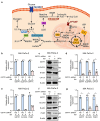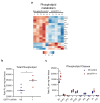GSTP1 knockdown induces metabolic changes affecting energy production and lipid balance in pancreatic cancer cells
- PMID: 40524738
- PMCID: PMC12169041
- DOI: 10.1080/23723556.2025.2518773
GSTP1 knockdown induces metabolic changes affecting energy production and lipid balance in pancreatic cancer cells
Abstract
Pancreatic ductal adenocarcinoma (PDAC) is an aggressive cancer with limited treatment options, underscoring the need for novel therapeutic targets. Metabolic reprogramming is a hallmark of PDAC, enabling tumor cells to sustain rapid proliferation and survive under nutrient-deprived conditions. While glutathione S-transferase pi 1 (GSTP1) is a known regulator of redox homeostasis in PDAC, its role in metabolic adaptation remains unclear. Here, we show that GSTP1 knockdown disrupts PDAC metabolism, leading to downregulation of key metabolic enzymes (ALDH7A1, CPT1A, SLC2A3, PGM1), ATP depletion, mitochondrial dysfunction, and phospholipid remodeling. Phospholipid remodeling, including an increase in phosphatidylcholine (PC) levels, further suggests a compensatory response to metabolic stress. Importantly, GSTP1 knockdown led to elevated lipid peroxidation, increasing 4-hydroxynonenal (4-HNE) accumulation. Treatment with the antioxidant N-acetyl cysteine (NAC) partially restored metabolic gene expression, reinforcing GSTP1's role in the interplay between redox regulation and metabolism in PDAC. By disrupting multiple metabolic pathways, GSTP1 depletion creates potential therapeutic vulnerabilities that could be targeted through metabolic and oxidative stress-inducing therapies to enhance treatment efficacy.
Keywords: Pancreatic ductal adenocarcinoma; glutathione S-transferase pi 1 (GSTP1); metabolic reprogramming; metabolomics; therapeutic targeting.
© 2025 The Author(s). Published with license by Taylor & Francis Group, LLC.
Conflict of interest statement
No potential conflicts of interest were disclosed.
Figures






Similar articles
-
Glutathione S-Transferase pi-1 Knockdown Reduces Pancreatic Ductal Adenocarcinoma Growth by Activating Oxidative Stress Response Pathways.Cancers (Basel). 2020 Jun 9;12(6):1501. doi: 10.3390/cancers12061501. Cancers (Basel). 2020. PMID: 32526885 Free PMC article.
-
Multiomics analysis of GSTP1 knockdown pancreatic cancer cells reveals key regulators of redox and metabolic homeostasis.Biol Open. 2025 Aug 15;14(8):bio061986. doi: 10.1242/bio.061986. Epub 2025 Aug 14. Biol Open. 2025. PMID: 40719618
-
Overall survival of pancreatic ductal adenocarcinoma is doubled by Aldh7a1 deletion in the KPC mouse.Theranostics. 2021 Jan 19;11(7):3472-3488. doi: 10.7150/thno.53935. eCollection 2021. Theranostics. 2021. PMID: 33537098 Free PMC article.
-
Metabolic reprogramming by driver mutation-tumor microenvironment interplay in pancreatic cancer: new therapeutic targets.Cancer Metastasis Rev. 2021 Dec;40(4):1093-1114. doi: 10.1007/s10555-021-10004-4. Epub 2021 Dec 2. Cancer Metastasis Rev. 2021. PMID: 34855109 Review.
-
Targets (Metabolic Mediators) of Therapeutic Importance in Pancreatic Ductal Adenocarcinoma.Int J Mol Sci. 2020 Nov 12;21(22):8502. doi: 10.3390/ijms21228502. Int J Mol Sci. 2020. PMID: 33198082 Free PMC article. Review.
References
LinkOut - more resources
Full Text Sources
Research Materials
Miscellaneous
